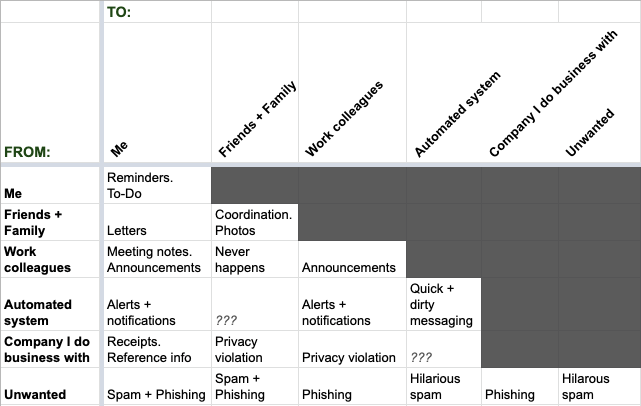Information - Knowledge and Productivity
“AAAAAAA, THERE IS TOO MUCH INFORMATION!” - me, every day
The world has ever-increasing amounts of information. It’s a monster: useful if trained, detrimental otherwise.
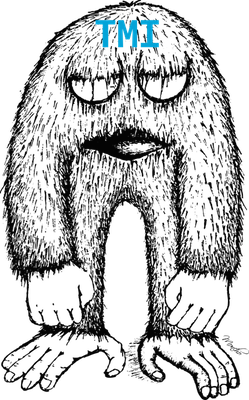
What I do depends on what I know at the time. For example, here are my info-centric questions from last week:
- What input/output structures are optimal for scrnaseq workflows spanning multiple labs?
- What do I cook next week, factoring in my health, food costs, and personal tastes?
- What’s the most effective way to teach the 9 newcomers in the musical group I direct?
- What should I do with my last job’s 401K, considering the fees are too high?
- Where should I take a friend to see music next week, factoring in cost, their musical preferences, and schedule constraints?
- How do I make sure I get my work done, prioritize my health, spend time with friends, play music, sleep enough, and leave time to be spontaneous? How do I do this in a low-stress way?
When in Doubt, Generalize

Last week’s questions generalize to a few topics: intelligence augmentation, information retrieval, external memory, and habit formation.
Along with higher-level topics, I have constraints:
- Money - I can’t afford a personal assistant, chef, or to quit my job.
- Time - Most of my hours are spoken for.
- Focus - I must optimize for my median brainpower, not my full capacity.
- Inertia - I can change quickly, easily, or a lot…pick two.
Goals
Knowing the problem and background, I want goals. What would a solution to TMI look like?
- Ability - Enable me to do what I want to do at any time, with the minimum amount of structure or interruptions.
- Search - Enable me to find all the information I need, and only the information I need, in less than 10 seconds
- Additions - Be able to add new information or structures in less than 30 seconds
- Routines - Enable me to adopt, reflect, and change processes/habits with minimal effort.
- Change - Be portable, so I can shift my information to other tool(s) with minimal effort
- Privacy - Serve only me. I want minimal risk that this information will be used against me in the future.
I want to organize my information, and make it optimally useful at minimal cost.*
* - Yes, I based my goal on Google’s mission statement.
Too Much To Remember
What’s your favorite way to pack for a weekend trip? What has experience taught you about how to build AWS Lambda layers? What’s the name of that thing you wanted to get at IKEA?

It’s impossible to remember everything; there’s too much information (TMI!). Rather than resort to a drunkard’s search, I want to organize my information, and make it optimally useful at minimal cost.
The Memory Palace
One of my primary tools is a personal knowledgebase, a form of external memory.
Since it’s a way for me to organize huge amounts of information, I think of it as a memory palace.

Kubernetes
Let’s look at an example. I was recently building a Kubernetes replicaset, and had to remember details about network overlays, Vault secrets, and health checks. There were two ways for me to do this:
- Remember it, by using memory techniques
- Access it quickly, either via search, or by other methods of information retrieval.
I knew about the incredible effectiveness of checklists, so you can guess which option I went with…
Requirements
Knowledgebases have common traits:
- Most information is static or infrequently changing.
- There’s a large variety of content, including text, videos, tables, graphics, and audio.
- There are lots of references to public information: news websites, software documentation, and YouTube videos.
It was pretty clear that I needed a wiki, a common type of transactive memory. There are other options…sort of.

I had design requirements:
- Highly secure. I’ll be putting personal information on here, snippets of work code, notes on my relationships.
- A design, build, and deploy time of less than 3 days.
- A simple design.
In addition, I had technical requirements:
- All data is stored in files, and only in files. No backend database.
- Support for Markdown formatting
- Can run on Mac OS.
- Free and open source.
After taking a look at dozens of different options, I had a shortlist: MDwiki and Wiki.js. Of these two, only MDwiki had all the features I wanted.

Unleash the Dev
Thankfully the installation and setup for MDwiki is very, very simple. I was able to get a basic setup working in about an hour.
I’ve published my installation instructions and basic on GitHub. There are also a suite of Layout and Gimmicks features I haven’t experimented with yet.
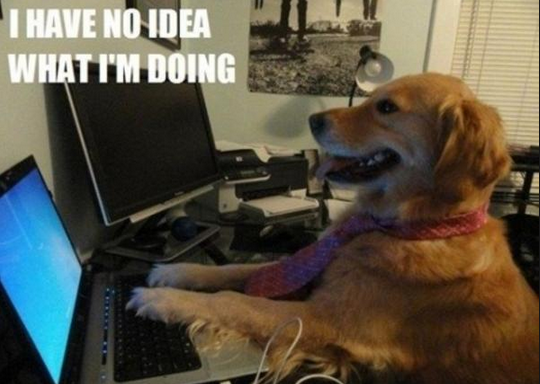
Success!
The results were everything I could hope for…

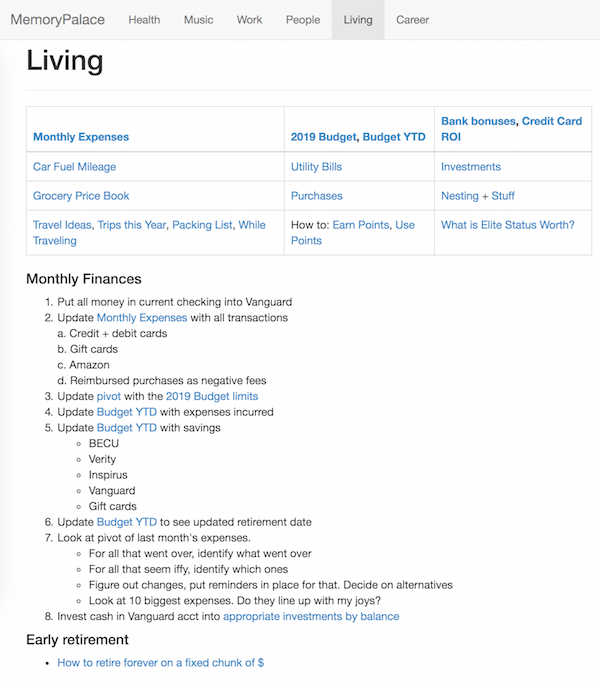
A few features stand out:
- Simple design. My data is stored in Markdown files, and Dropbox syncs everything.
- Low power usage. The only service running is Nginx, which is famously efficient.
- Secure by default. None of the data being served leaves my computer, except via Dropbox sync. When I browse to my site, I am connecting to
localhost:1138 - Easy to browse. I put in only the structure I need.
- Easy to change. All I need to do is edit a Markdown file. It doesn’t get simpler than that.
4 of my original goals are relevant to this work:
- Ability - Enable me to do what I want to do at any time, with the minimum amount of structure or interruptions.
- Search - Enable me to find all the information I need, and only the information I need, in less than 10 seconds
- Additions - Be able to add new information or structures in less than 30 seconds
- Privacy - Serve only me. I want minimal risk that this information will be used against me in the future.
The only goal not natively supported is Search. Though I can still search the wiki contents using Spotlight.
I have one outstanding security bug, because browser CORS restrictions don’t work for localhost.
This tool does exactly what I want it to.
Too Much Going On
What was that errand I had planned after work tomorrow? When’s my next dentist appointment? Which friend wanted to borrow my car this weekend?

I cannot remember everything I’m going to do today, let alone this week, or next month. There’s too much information (TMI!). Rather than rely on my memory or a huge collection of email, I want to organize my information, and make it optimally useful at minimal cost.
I’ve already talked about how I do this with my Memory Palace. The tool I use most, however, is a to-do list.
The Hourglass
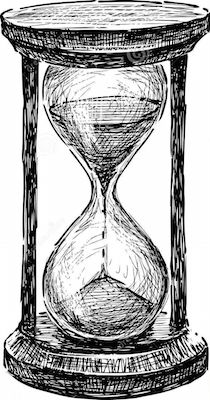
There is never enough time
I have too many things to do. I’m sure this is unique to me. Surely no one else is busy, overworked, or juggling too many responsibilities. Right? Right.

Because I’m one of those weirdos with too much to do, I try to be prudent with my time.
That means:
- I want to do each task as efficiently as possible
- I want to get more things done in the same amount of time
- I want to do each task with less and less mental effort over time.
The Magic of Context

comic courtesy of Jason Heeris
People are terrible at multitasking. Therefore, one way to be very productive is to group together like-minded things together.
For example:
- Pay my rent on time. And my garbage bill. And my phone bill. And my credit card bill, while I’m at it.
- Cook food for the week. While I’m at it, make a vat of tea. Cut up fruit for snacks
- Get groceries after work. Oh, and don’t forget to get some WD-40, you’re running low. Oh, and pick up that tent from a friend.
- Do my workout in the morning, as soon as I wake up. Oh, and shave right after. Might as well trim my nails then, too.
When I group together like-minded tasks, I can do them with less effort overall. Tasks in the same context flow together.
The Elephant and the Mouse

One of the most useful books I’ve ever read is Thinking, Fast and Slow. It describes a person’s mind as a mouse riding an elephant.
The mouse (your conscious mind) is trying to direct the elephant (your habits & instincts). Most of the time the elephant goes where it wants. The mouse can steer very gradually (i.e. forming habits) or by sheer force (i.e. willpower). In the latter case, the mouse will quickly exhaust itself.
This describes my daily life perfectly. I have a limited supply of willpower (like everyone else), and must allocate it wisely. I have found 2 approaches that work well:
Proactively Form Habits
I’m very much a creature of habit, and that has served me well. For example, my big push this year is to focus on my health, and so I’ve been slowly making a habit of meal prepping, sleeping enough, taking breaks, cycling, working out, and rewarding myself for good behavior.
Baby Steps
The second approach is ‘baby steps’; I will break a task into tiny, trivially easy to do pieces. It’s then easy for me to breeze through them, because the mental effort involved in any single step is miniscule.

The Tool
I had a few requirements for a to-do list tool, based on how I organize tasks:
- Works on all of my devices (laptops, smartphone, desktop) and stays in sync
- Supports prioritizing tasks, at least a bit (high, medium, low)
- Has support for tasks with due-dates
- Supports recurring tasks
- Has enough organizing structure that I can easily segment my tasks by context/topic.
I’ve experimented with several different approaches over the years, including:
- Microsoft OneNote, synced with Dropbox
- Google Calendar
- Google Inbox
- Wunderlist
However, none of these had enough organizing structure, or the right design for a to-do list. It was only last year that I found a really good tool: Todoist.
I was initially skeptical, since I’d used Wunderlist, and it didn’t let me segment/cluster items enough. The breakthrough was reading about a Getting Things Done blog post by Vernon Johnson, describing his Todoist setup.
Todoist
Todoist is quite simple. You can create tasks. Each one can belong to a project, have tags, a due date, a priority, and can be recurring or not.
I set up my projects to be categories (e.g. music, work, travel, house, friends)
Grouping
The most natural grouping for me is by time:
- Morning tasks (before work)
- Midday tasks (during the work day)
- Afternoon tasks (right after work)
- Evening tasks (once I’m back in my house)
- Quick tasks (takes less than 10 minutes)
Tags are how I make this magic happen. I’ll tag a task with @morning, and I will see it when I roll out of bed and check my ‘Morning’ list.
Let’s say I want to work out three mornings a week. I can create three recurring tasks, one for each day of the week, and tag them with ‘morning’,
Here are my tasks this afternoon:
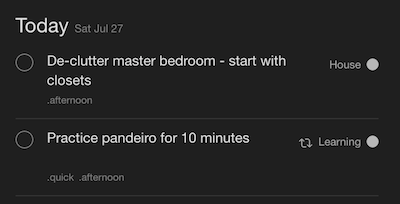
…and some of tomorrow’s tasks, organized by project:
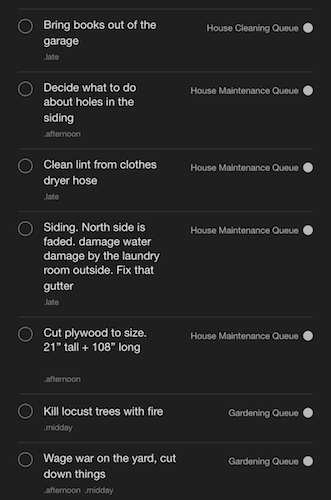
But Beware…
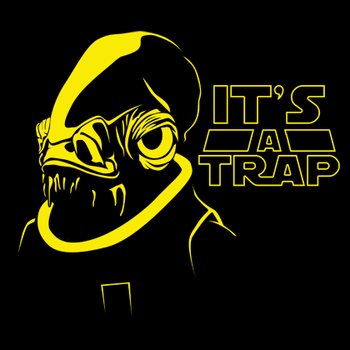
It’s very, very, very tempting to use productivity tools to get more done. However, that’s a cycle without an end; you’ll end up doing more, instead of getting time back.
“When everything is important, nothing is”
To decide what to do, decide on what’s important. That means making conscious choices on what is not important. If you’re like me, it’s painful to decide that a whole category of things isn’t important (e.g. ‘house repairs’, or ‘travel’).
I cannot overstate how valuable it is, though. I decide on my priorities every month, and change what I do as a result.
I use a mnemonic when adding/changing tasks:
- Leave - Do I really need to do this? Is it really important to me? If not, can I get rid of it, or leave it for a later month?
- Link - For this task, what other tasks are similar? Does it make sense to link them together?
- Limit - How can I keep limit this task’s time/scope/effort? Can I break it into pieces?
The result? I can be really damn productive, and then I can stop and enjoy life.
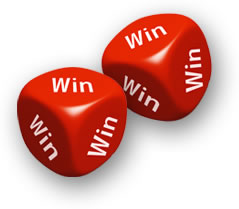
Communication
How do I coordinate with 8 people in different groups? How does an airline tell me about changes to next week’s flight? What’s a good way for a long-lost friend to reach me?
The most popular online communication tool is one of the oldest: email. It’s used for everythig: personal messages, alerts, marketing, etc.
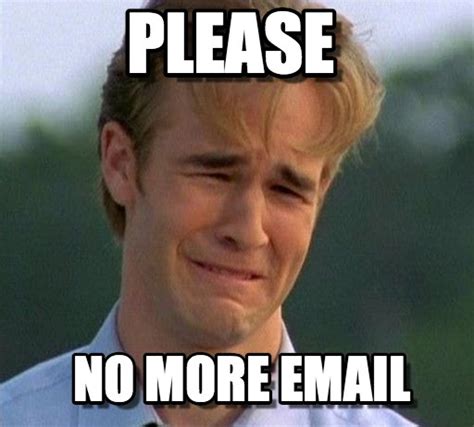
Email is a beast that follows our every footstep.

Its flexibility makes it a challenge. I get emails with varying mental and time requirements. How can I process the emails I receive? How can I send emails that gets me the responses I’m looking for?
I want to organize my communication, and make it optimally useful at minimal cost.
Context
Email sits in the intersection of security, identity, privacy, communication, and human perception.
There are assumptions we make:
- Only I can read my email
- I can contact someone via email and only they will see it
- I can store emails in my account and they will be secure
- It’s a good way to send information to people
- It’s a good way for people to send information to me
- I can look over my emails later, if I need to find something again.
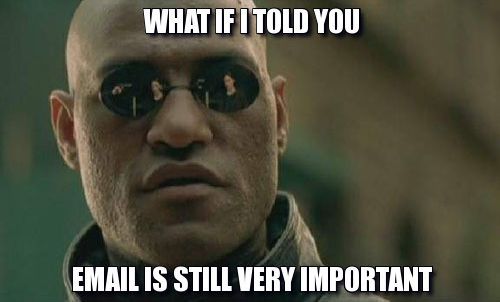
Consider identity. I bet you have an email address, or more than one. They are part of your identity. Heck, you may advertise them on your blog, or a business card.
Second, ubiquity. Email has powerful network effects and utility. Anyone can contact you, and you can respond to them instantly. Network effects influence your life.
What about privacy? Someone can find your email address by Googling your name. Email is a public way to contact you. Your phone number and physical address have some expectation of privacy. Your email address, not so much.
Security is a big consideration. Institutions you interact with use email to authenticate you. For example, online banking requires an email address. Your phone company, landlord, and airline all know it.
If I had nefarious intentions, knowing your email address is a way to target you. It’s the skeleton key to your online life. Good email security fundamentals are critical.
Uses
I categorize email by its intended use:
- Personal communication - sending messages to loved ones. This is the closest analogy to writing a personal letter & mailing it.
- Work communication - sending/receiving messages, often for coordination purposes. This is being superseded by messaging applications like Slack.
- Personal notes - reminders to myself, e.g.
Get coffee on the way home,put $ into savings tonight, orremember your passport - Reference - Useful details, often within a specific timeframe. Plane ticket confirmations are a great example.
- Alerts - Important + infrequent automated messages. Bank fraud warnings are one example.
- Unwanted - Spam. Phishing attempts. Contact from companies you may have interacted with, but don’t want to hear from again. This is 99% of the email you receive; thank goodness for spam filters.
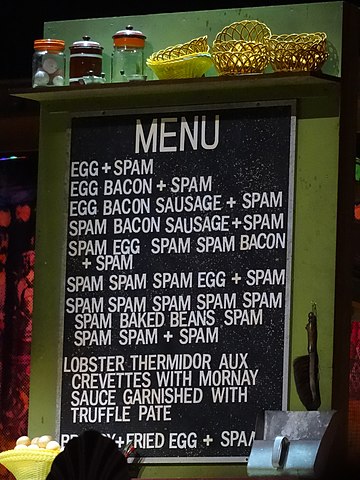
Some of these intended uses overlap. Others conflict.
Let’s categorize the way I use email a different way - sources and destinations:
Interaction Patterns
There are common email interaction patterns:
Quick Items
I use email to send quick messages, alerts, or announcements. These messages take only a few minutes to resolve.
Search
Some emails are a knowledgebase. This is common; that’s why Gmail’s main interface is search.
Threads
Modern email apps group a conversation into a thread.
Timing
An email is often useful at a certain time. For example, that email confirmation about my flight? I want receive it soon after booking, and then ‘snooze’ it until a few days before I travel. It’s clutter in the interim.
A missive from a friend, on the other hand? I want to see it immediately.
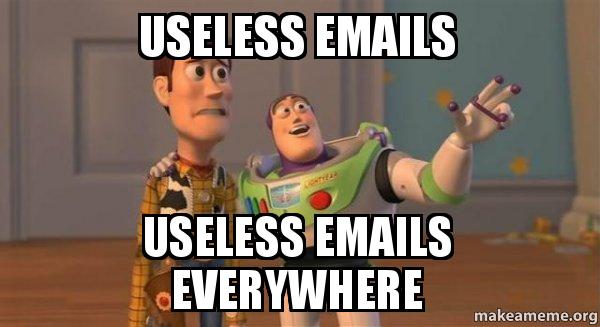
Make Tools Yours
Tools are for your use. They should suit your needs, not the other way around.
I use different email accounts for different purposes: for friends, for work, and for my career. Each account has different settings for notifications, app integration, and privacy.
Communication
Email is a tool for transmitting text. This has great advantages (permanence, legibility). It also has drawbacks (tone of voice, no body language). There’s a margin of error, and it’s pretty big. Words are ambiguous. Connotations and idioms are not universal.
With any communication tool, there is a gap between what you intend to say and what people perceive.
People don’t read email. Many people spend < 60 seconds reading an email. Many things compete for our attention; giving everything short shrift is natural.
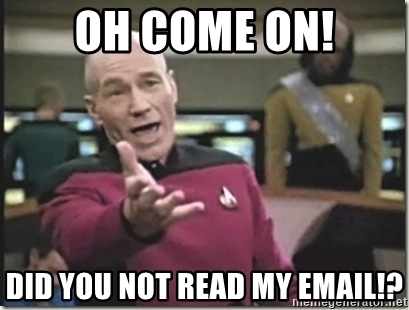
Email suffers from the timing and frequency constraints that bedevil all communication. Being effective is key.
Here’s what I do:
- Keep it short. Shorter. Even shorter than that.
- “Is this the minimal length that has necessary info?”
- Put the important details at the top, in bullet points
- Message only when necessary. Repetition breeds disregard
- Long emails are ignored. Go for clarity & brevity. If elaborate details are important, do it by voice. The bandwidth is far higher.
- No ambiguity. I use inside jokes, but only with people who know them.
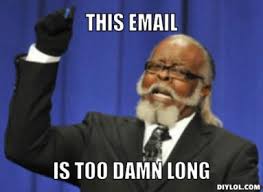
Email is useful sometimes:
- “Can the recipient resolve this in < 3 minutes?”
- “Does this need minimal interaction?”
- Back-and-forth is messaging. Anything else, and use high-bandwidth voice.
- “Will this person need to find this in several days?”
I use standard formats:
Work Communication
Tl;dr - <one-sentence summary>
The Long Version:
<background>
<process + data>
<result>
Announcements + Notifications
I send announcements at times.
Hey folks, here's the details for <event/subject>
* When -
* Where -
* What to Bring -
* Important Topic -
The consistency and format works well for distracted people.

Search
Search is a different beast; my words interact with a search utility, and not a human.
I use keywords. If I’m writing about a trip to LA in March, I’ll include words like ‘family’, ‘flight’, ‘travel’, ‘itinerary’, ‘March’, ‘California’, ‘LA’, and ‘Los Angeles’.
I can search using key words/phrases to find this email, quickly. This is an old trick. If you get an email with a plane ticket confirmation, or an Amazon order, it has key words & phrases in it.
To-Do
These are very short. For example, today I wrote a reminder to myself, to get my niece some books:
niece books
…that’s it. Just enough to jog my memory. I’ll route it into my to-do system later.
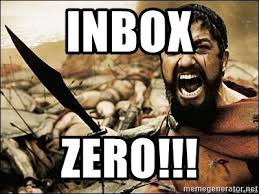
Email is a tool. Its effects depend on our intentions, and our methods.
I use email in specific ways because I’m perennially busy. I’d rather spend my time on better problems than puzzling out the optimal format for each email.
How do you use email?
Conclusion
There are many ways to organize information. We do different things with information (search, communicate, reference, plan), meaning we have different requirements and mental approaches. This means using multiple tools, or one all-encompassing tool. I’ve never found the latter approach to work well.
How do you use and organize information?
Published 07 July 2019
